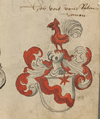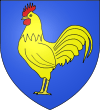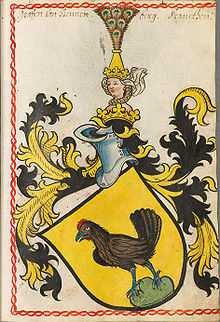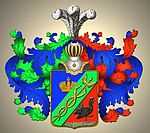von Hahn
The name von Hahn (German "Hahn" equals the expression of rooster) is a German-Baltic-Russian noble family.
Origin
The origin of the name and the gender is not clear. The first Hahn, with whom this coat of arms is associated, is mentioned in the historical annals as Eckhard[1] the I-st, or "Eggehardus Gallus" in Latin original. In 1230 he is referred to as a councilor and a knight of the Duke Johann the I-st of Mecklenburg. Not much is known about his ancestors, though the family legend points to Franconia as a place of family's origin. Regarded by some researchers [2] as highly improbable on mostly geographical grounds,[2] this theory deserves further investigation due to close connections between the Obotrit's house of Mecklenburg and that of Franconian Hennebergs. The marriage in 1229 (a year before Eckhard Hane appears in chronicales) between the Johann and Luitgart von Henneberg,[3] daughter of Poppo VII. von Henneberg, is of particular interest as it establishes a direct link between these two.



There is a similarity between the Hahn's coat of arms, the old Franconian families of Rothenhahn and Hahnsberg, further reinforced by the 'historical' form of the name of the Öesel's Hahn family: "Hahn genannt Rothenstern". Interesting similarity exists between the Hahn's coat of arms and that of the de Vogüé family of the Aubenas, France.
Finally, it is worth noticing the proximity between the name and the coat of arm of the Hennebergs (literally "Rooster's mountain) and the Hahns, rooster being its main point of reference.
The origin of the Baltic Hahn families deserves further research. Presumed, thought unproven, connection between the Hahn family in Mecklenburg and the families in Courland[4] and Öesel is a conventional explanation of their coat of arms's being identical to one another and virtually identical to that of the descendants of Eckhard Hahn.[5]
The Ösel's Hahn family was accepted into the Nobility Corporation in 1849 with the arms of the Coulrand Hahns. In Russia this part of the family was also incorporated into Russian Nobility with the coat of arms, granted by the Catherine II.[6]
History
Von Hahns have distinguished themselves through their outstanding service to the sovereigns of Russian, Holy Roman and German Empires, kings and queens of Denmark, Sweden and Poland.
Mecklenburg: Notable members:
- Ida, Countess von Hahn-Hahn – novelist
Courland: The history of the Baltic Hahns begins from Johann Hane referred to in 1318 as a vassal of the Danish king Erik. It is thought that Johann is a direct descendant of Eckhard Hane through his son Heinrich.
In 1318 AD king Erik of Denmark, granted lands to Johann Hane "for knightly and praise worthy deeds". Johann's brother, Reimar Hane, was Master of the German Order (in Livonia) from 1324 to 1328. In 1476 Berndt von der Borch, Master of the Order, granted Heinrich Hahn with the Postenden estate, which remained in the same hands until 1939 - longest uninterrupted land ownership in Courland. 1862 Ukaz of the Russian Imperial Senat allowed the family to use the title "Baron" officially.
Notable members:
- Reimar Hane — Master of the German Order (1324–1328)
- Paul Theodor von Hahn (1793–1862) — Privy Councillor, civil governor of Courland (1824–1827), and of Livland (1827–1829), Senator and Imperial State Council member, honorary member of the Russian Academy of Sciences.[7]
Ösel: descendants of Johann August von Hahn. Family incorporated into the Ösel's Nobility Corporation in 1849.[8]
Notable members:
- Johann August von Hahn (c. 1730 – 1799) — Privy Councillor to the Empress Catherine II, General-director of the St.Petersburg Post Department and Imperial Postmaster[9]

- Friedrich August von Hahn (1761–1851) — Actual State Councillor, St.Petersburg post Director[10]
Russian Empire: cadet branch of the Ösel family; descendants of Otto Karl v H, younger brother of Friedrich August v H (and son of Johann August von Hahn). Recorded at the Nobility Genealogical Book of Saint Petersburg Governorate. Members of the family use the title "Baron", alongside Hahn coat of arms.[11][12]
Notable members:
- Eugen Kaspar von Hahn (1807–1874) — Senator, Privy Councillor[13]
- Alexander von Hahn (1809–1895) — General of the Infantry, member of the Military Council of the Minister of War[14]
- Dmitry K. von Hahn (1830–1907) — General of the Infantry, Inspector of the Border Guard Corps
- Sergey D. (1860–1914) — Actual Privy Councillor, President of the Russian Imperial Bank, Deputy Minister of Trade and Industry[15]
See also
External links
References
- ↑ Kneschke, E.H. (1863). Neues allgemeines Deutsches adels-lexicon: im vereine mit mehreren historikern (Bd. 4). F. Voight. Retrieved 2015-01-01.
- ↑ 2.0 2.1 Ingolf Vogel. "FG Hahn - Die Herkunft der Hahn". vogel-soya.de. Retrieved 2015-01-01.
- ↑ Marek, Miroslav. "meckl/meckl1.html". Genealogy.EU.
- ↑ Ingolf Vogel. "FG Hahn - Die Linien des Geschlechts Hahn". vogel-soya.de. Retrieved 2015-01-01.
- ↑ . However, there are also notable differences: Mecklenburg rooster has its beak, feet and top tail feathers painted black
- ↑ "Герб Гана". gerbovnik.ru. Retrieved 2015-01-01.
- ↑ "Erik-Amburger-Datenbank - Datensatz anzeigen". web.archive.org. Retrieved 2015-01-01.
- ↑ "Digitale Bibliothek - Münchener Digitalisierungszentrum". daten.digitale-sammlungen.de. Retrieved 2015-01-01.
- ↑ "Erik-Amburger-Datenbank - Datensatz anzeigen". web.archive.org. Retrieved 2015-01-01.
- ↑ "Erik-Amburger-Datenbank - Datensatz anzeigen". web.archive.org. Retrieved 2015-01-01.
- ↑ In his Memoirs count Sergei Witte refers to General Dmitry von Hahn as "Baron Hahn"
- ↑ Referring to General Alexander von Hahn Fyodor Dostoyevsky writes about "Baron Hahn" in his letter to L. Golovina from 4/7/1876 Archived April 23, 2007 at the Wayback Machine
- ↑ "Erik-Amburger-Datenbank - Datensatz anzeigen". web.archive.org. Retrieved 2015-01-01.
- ↑ "Erik-Amburger-Datenbank - Datensatz anzeigen". web.archive.org. Retrieved 2015-01-01.
- ↑ "Erik-Amburger-Datenbank - Datensatz anzeigen". web.archive.org. Retrieved 2015-01-01.